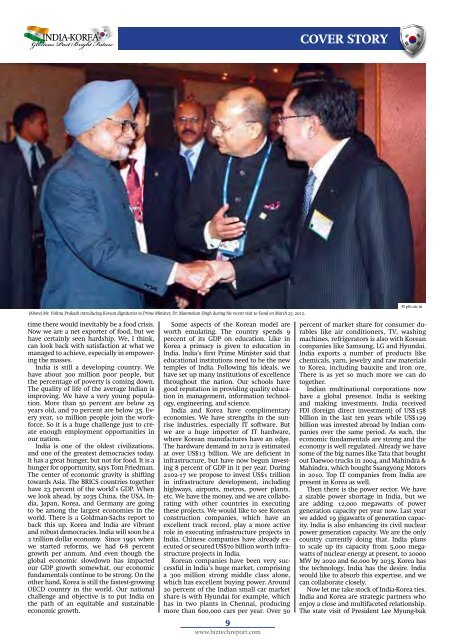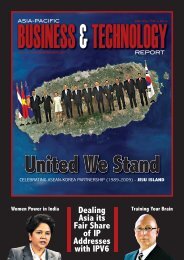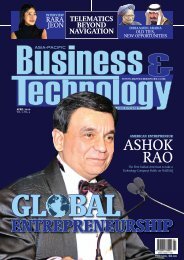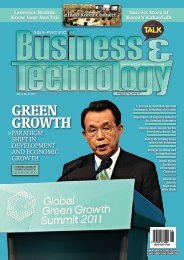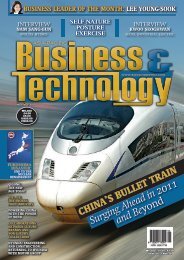INDIA-KOREA - Asia-Pacific Business and Technology Report
INDIA-KOREA - Asia-Pacific Business and Technology Report
INDIA-KOREA - Asia-Pacific Business and Technology Report
Create successful ePaper yourself
Turn your PDF publications into a flip-book with our unique Google optimized e-Paper software.
<strong>INDIA</strong>-<strong>KOREA</strong><br />
Glorious Past Bright Future<br />
cover story<br />
(Above) Mr. Vishnu Prakash introducing Korean dignitaries to Prime Minister, Dr. Manmohan Singh during his recent visit to Seoul on March 25, 2012.<br />
time there would inevitably be a food crisis.<br />
Now we are a net exporter of food, but we<br />
have certainly seen hardship. We, I think,<br />
can look back with satisfaction at what we<br />
managed to achieve, especially in empowering<br />
the masses.<br />
India is still a developing country. We<br />
have about 300 million poor people, but<br />
the percentage of poverty is coming down.<br />
The quality of life of the average Indian is<br />
improving. We have a very young population.<br />
More than 50 percent are below 25<br />
years old, <strong>and</strong> 70 percent are below 35. Every<br />
year, 10 million people join the workforce.<br />
So it is a huge challenge just to create<br />
enough employment opportunities in<br />
our nation.<br />
India is one of the oldest civilizations,<br />
<strong>and</strong> one of the greatest democracies today.<br />
It has a great hunger, but not for food. It is a<br />
hunger for opportunity, says Tom Friedman.<br />
The center of economic gravity is shifting<br />
towards <strong>Asia</strong>. The BRICS countries together<br />
have 23 percent of the world’s GDP. When<br />
we look ahead, by 2035 China, the USA, India,<br />
Japan, Korea, <strong>and</strong> Germany are going<br />
to be among the largest economies in the<br />
world. There is a Goldman-Sachs report to<br />
back this up. Korea <strong>and</strong> India are vibrant<br />
<strong>and</strong> robust democracies. India will soon be a<br />
2 trillion dollar economy. Since 1991 when<br />
we started reforms, we had 6-8 percent<br />
growth per annum. And even though the<br />
global economic slowdown has impacted<br />
our GDP growth somewhat, our economic<br />
fundamentals continue to be strong. On the<br />
other h<strong>and</strong>, Korea is still the fastest-growing<br />
OECD country in the world. Our national<br />
challenge <strong>and</strong> objective is to put India on<br />
the path of an equitable <strong>and</strong> sustainable<br />
economic growth.<br />
Some aspects of the Korean model are<br />
worth emulating. The country spends 9<br />
percent of its GDP on education. Like in<br />
Korea a primacy is given to education in<br />
India. India’s first Prime Minister said that<br />
educational institutions need to be the new<br />
temples of India. Following his ideals, we<br />
have set up many institutions of excellence<br />
throughout the nation. Our schools have<br />
good reputation in providing quality education<br />
in management, information technology,<br />
engineering, <strong>and</strong> science.<br />
India <strong>and</strong> Korea have complimentary<br />
economies. We have strengths in the sunrise<br />
industries, especially IT software. But<br />
we are a huge importer of IT hardware,<br />
where Korean manufactures have an edge.<br />
The hardware dem<strong>and</strong> in 2012 is estimated<br />
at over US$13 billion. We are deficient in<br />
infrastructure, but have now begun investing<br />
8 percent of GDP in it per year. During<br />
2102-17 we propose to invest US$1 trillion<br />
in infrastructure development, including<br />
highways, airports, metros, power plants,<br />
etc. We have the money, <strong>and</strong> we are collaborating<br />
with other countries in executing<br />
these projects. We would like to see Korean<br />
construction companies, which have an<br />
excellent track record, play a more active<br />
role in executing infrastructure projects in<br />
India. Chinese companies have already executed<br />
or secured US$70 billion worth infrastructure<br />
projects in India.<br />
Korean companies have been very successful<br />
in India’s huge market, comprising<br />
a 300 million strong middle class alone,<br />
which has excellent buying power. Around<br />
20 percent of the Indian small car market<br />
share is with Hyundai for example, which<br />
has in two plants in Chennai, producing<br />
more than 600,000 cars per year. Over 50<br />
9<br />
www.biztechreport.com<br />
© pib.nic.in<br />
percent of market share for consumer durables<br />
like air conditioners, TV, washing<br />
machines, refrigerators is also with Korean<br />
companies like Samsung, LG <strong>and</strong> Hyundai.<br />
India exports a number of products like<br />
chemicals, yarn, jewelry <strong>and</strong> raw materials<br />
to Korea, including bauxite <strong>and</strong> iron ore.<br />
There is as yet so much more we can do<br />
together.<br />
Indian multinational corporations now<br />
have a global presence. India is seeking<br />
<strong>and</strong> making investments. India received<br />
FDI (foreign direct investment) of US$158<br />
billion in the last ten years while US$129<br />
billion was invested abroad by Indian companies<br />
over the same period. As such, the<br />
economic fundamentals are strong <strong>and</strong> the<br />
economy is well regulated. Already we have<br />
some of the big names like Tata that bought<br />
out Daewoo trucks in 2004, <strong>and</strong> Mahindra &<br />
Mahindra, which bought Ssangyong Motors<br />
in 2010. Top IT companies from India are<br />
present in Korea as well.<br />
Then there is the power sector. We have<br />
a sizable power shortage in India, but we<br />
are adding 12,000 megawatts of power<br />
generation capacity per year now. Last year<br />
we added 19 gigawatts of generation capacity.<br />
India is also enhancing its civil nuclear<br />
power generation capacity. We are the only<br />
country currently doing that. India plans<br />
to scale up its capacity from 5,000 megawatts<br />
of nuclear energy at present, to 20000<br />
MW by 2020 <strong>and</strong> 60,000 by 2035. Korea has<br />
the technology, India has the desire. India<br />
would like to absorb this expertise, <strong>and</strong> we<br />
can collaborate closely.<br />
Now let me take stock of India-Korea ties.<br />
India <strong>and</strong> Korea are strategic partners who<br />
enjoy a close <strong>and</strong> multifaceted relationship.<br />
The state visit of President Lee Myung-bak


